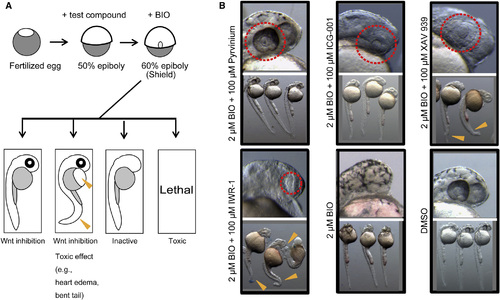Fig. 1
- ID
- ZDB-FIG-140523-63
- Publication
- Nishiya et al., 2014 - A Zebrafish Chemical Suppressor Screening Identifies Small Molecule Inhibitors of the Wnt/beta-catenin Pathway
- Other Figures
- All Figure Page
- Back to All Figure Page
|
A Zebrafish Assay for Chemical Suppressors Confirms Inhibitory Activities of Known Inhibitors of the Wnt Pathway (A) A schematic diagram of the zebrafish chemical suppressor screening is shown. Chemical suppressors of the eyeless phenotype were identified. Embryos were pretreated with test compounds at 50% epiboly and treated with BIO (a GSK3 inhibitor) at the shield stage, then incubated for 18 to 24 hr. Effects of the compounds were evaluated under a dissecting microscope. When eye development was restored to normal, the test compound was classified as a positive candidate for Wnt pathway inhibitors. When a developmental defect was observed, the adverse effect might reflect potential toxicity of the compound. Arrowheads indicate sites of toxic effects (e.g., heart edema, bent tail). (B) Known Wnt pathway inhibitors restored eye development in the presence of BIO. Pyrvinium (a casein kinase activator), ICG-001 (an inhibitor of interaction between β-catenin/TCF and CREB-binding protein), XAV939 (a tankylase inhibitor), and IWR-1 (an Axin stabilizer) at least partially reversed the BIO-induced eyeless phenotype at 100 µM (dotted lines). Treatments of XAV939 and IWR-1 resulted in malformation in tails (arrowheads). Images were taken at 30 hpf. |

